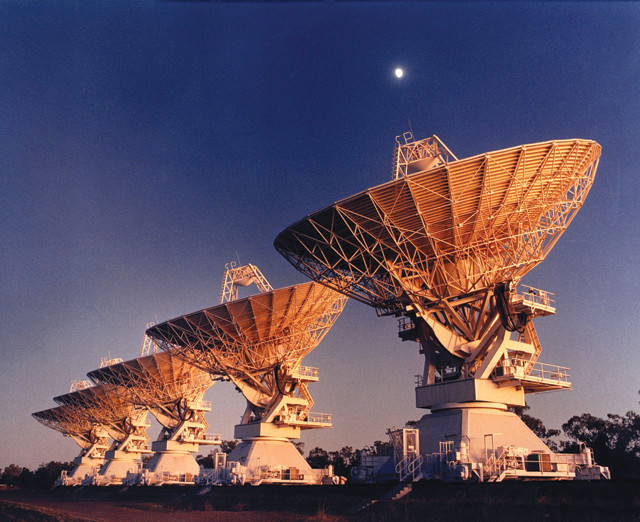
by Julia Rosen Monday, April 20, 2015

In addition to the Parkes telescope, the Australia Telescope Compact Array turned to look for evidence of the fast radio burst. Credit: ©John Masterson/CSIRO, CC BY 3.0.
Last year, astronomers received a signal from the depths of the cosmos: a fleeting pulse of intense electromagnetic radiation known as a fast radio burst (or FRB). First discovered in 2007, these millisecond blasts occur sporadically and continue to baffle astronomers. Now, for the first time, an FRB has been caught red-handed.
The radio telescope at Australia’s Parkes Observatory was trained on the right slice of sky when an FRB struck early in the morning on May 14, 2014. Within seconds, an automated monitoring program flagged the event and emailed observers, who then alerted staff at 12 other telescopes around the world. Over the next few hours, each of these instruments turned its gaze toward the burst’s source in search of clues to its origin.
Researchers led by Emily Petroff of the Swinburne University of Technology in Melbourne, Australia, estimated that the burst occurred up to 5.5 billion light years from Earth in an area that produced another burst in 2011, although the scientists think the two events are unrelated. They also observed, for the first time, that the radio waves associated with the burst were polarized, indicating it probably originated near a strong magnetic field.
The observations don’t point to any definitive source of FRBs, but the researchers did identify several objects of interest, including two active galactic nuclei — the energetic centers of galaxies that host phenomena like quasars — and a starburst galaxy. The results also rule out some candidate sources, like supernovae and gamma-ray bursts, which would have produced more light than the telescopes detected, the researchers reported in the Monthly Notices of the Royal Astronomical Society.
© 2008-2021. All rights reserved. Any copying, redistribution or retransmission of any of the contents of this service without the expressed written permission of the American Geosciences Institute is expressly prohibited. Click here for all copyright requests.